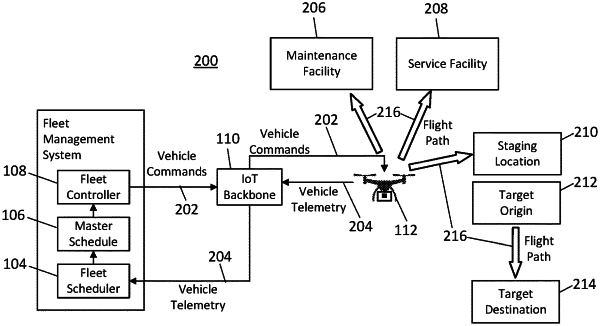| CPC G06Q 10/06311 (2013.01) [G06N 20/00 (2019.01)] | 19 Claims |

|
1. A fleet scheduler comprising:
a processor; and
a non-transitory computer-readable storage medium storing a program to be executed by the processor, the program including instructions for:
providing a user-defined constraint, the user-defined constraint comprising a total number of vehicles, a minimum number of active vehicles, a maximum wait time, or a minimum surplus energy requirement to complete a flight;
providing a user-defined parameter, the user-defined parameter being configured to weight a goal-seeking algorithm that initially uses decision trees that avoid considering randomness;
gathering monitored data representing real-world conditions, wherein the gathering the monitored data comprises at least receiving, from one or more vehicles, vehicle data received during operation of the respective one or more vehicles;
retrieving, for each vehicle of the one or vehicles, vehicle maintenance data associated with maintenance requirements and previously performed maintenance;
generating and maintaining predictive models based on the monitored data and the vehicle data, wherein the predictive models generate predicted data;
generating a master schedule for a plurality of vehicles based on the monitored data and the predicted data, wherein the master schedule optimizes a goal based on the user-defined constraint, the user-defined parameter, wherein each of the vehicles of the plurality of vehicles comprises one or more connected components, wherein the vehicle data comprises tracking data for both the vehicles of the plurality of vehicles and the connected components, wherein the master schedule includes data indicating one or more scheduled vehicle positions, one or more flight plans, and one or more maintenance schedules, and one or more service schedules associated with least one of recharging or refueling of a vehicle, and wherein the generating the master schedule comprises generating the one or more flight plans according to data from a UAF (unmanned aircraft systems) traffic management (UTM) system indicating approved flight corridors and restricted airspace, wherein the generating the master schedule further comprises generating the one or more maintenance schedules with sequenced schedules that maintain the minimum number of active vehicles and according to cycle times for performing maintenance work orders, cycle times between required maintenance, cycle times for technicians performing work orders, numbers of available technicians, and available replacement components;
modifying one or more of the one or more flight plans according to data from the UTM system indicating flight plan data for external vehicles, wherein the modifying the one or more of the one or more flight plans comprises adjusting the one or more flight plans to avoid conflicting with flight plan data for the external vehicles;
controlling one or more vehicles of the plurality of vehicles according to the master schedule, wherein controlling the one or more vehicles according to the master schedule comprises sending the master schedule to a fleet controller, the master schedule causing the fleet controller to generate commands according to the master schedule, and to send the commands to one or more vehicles of the plurality of vehicles, and wherein each maintenance schedule of the one or more maintenance schedules causes the fleet controller to generate commands for routing a respective vehicle to a maintenance facility;
receiving, through the fleet controller, operational data sent from one or more vehicles of the plurality of vehicles;
generating updated predicted data by updating the predictive models based on at least the operational data;
generating an updated goal seeking algorithm according to the operational data and the updated predicted data, wherein the updated goal-seeking algorithm uses stochastic models that consider real world randomness for goal-seeking;
generating an updated master schedule by updating the master schedule according to at least the operational data, the updated predicted data, and the updated goal seeking algorithm; and
controlling one or more vehicles of the plurality of vehicles according to the updated master schedule, wherein controlling the one or more vehicles according to the updated master schedule comprises sending the updated master schedule to the fleet controller.
|